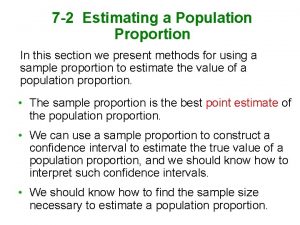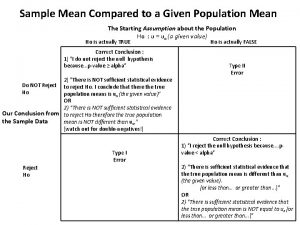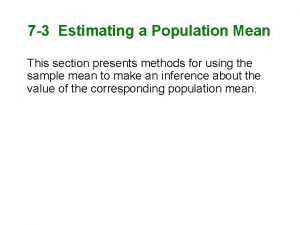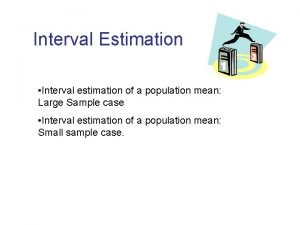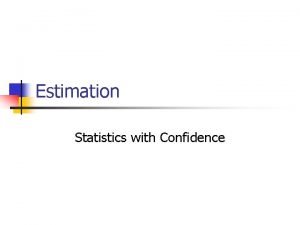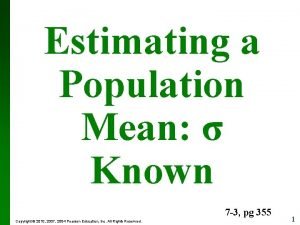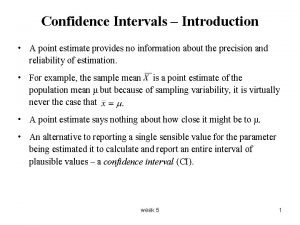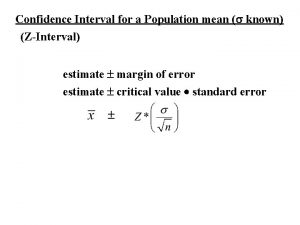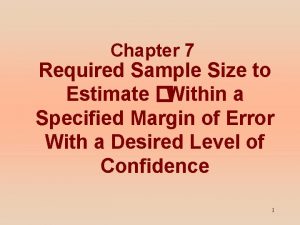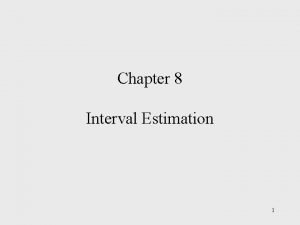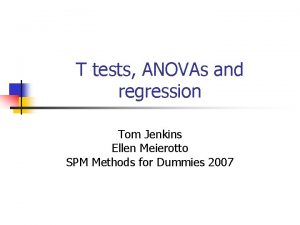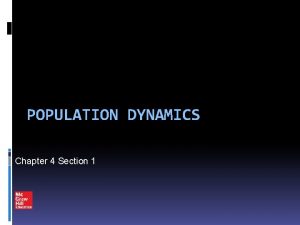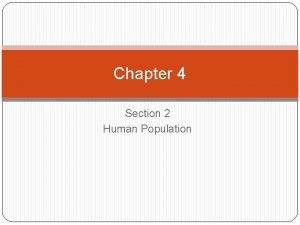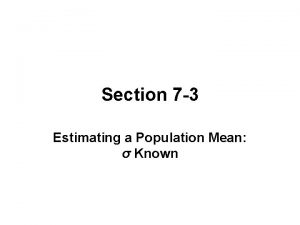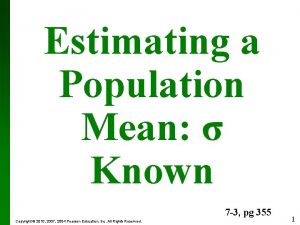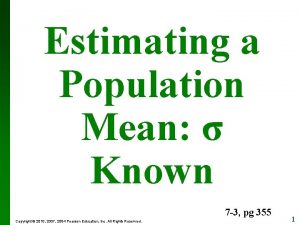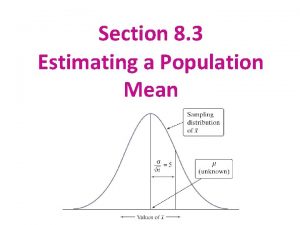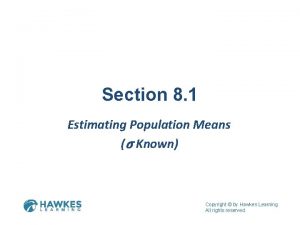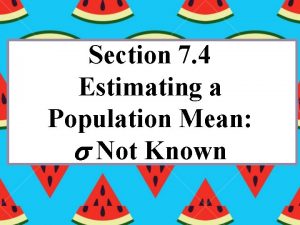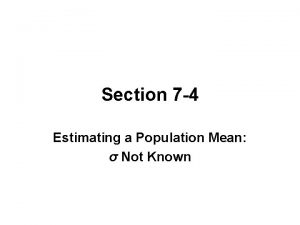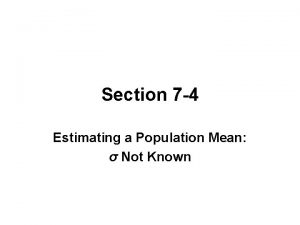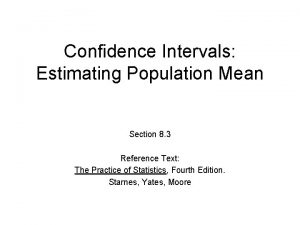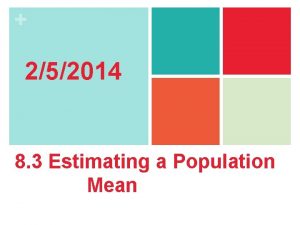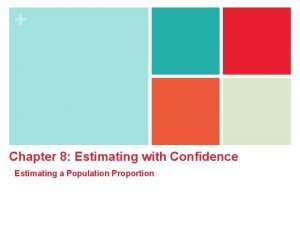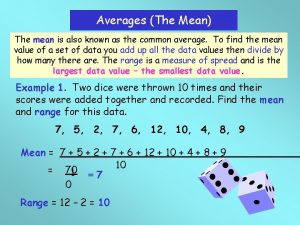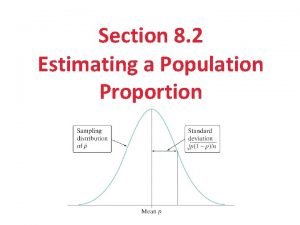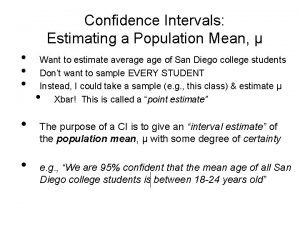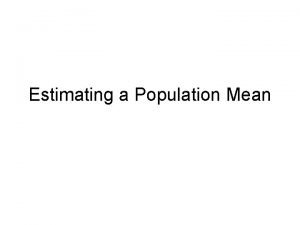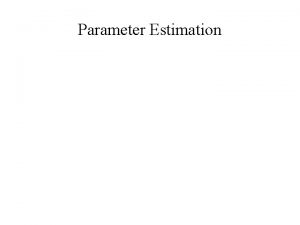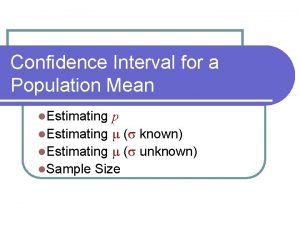Section 7 3 Estimating a Population Mean Known






















- Slides: 22

Section 7. 3 Estimating a Population Mean: Known

Learning Targets: • • This section presents methods for estimating a population mean. In addition to knowing the values of the sample data or statistics, we must also know the value of the population standard deviation, . There are three key concepts that should be learned in this section….

Learning Targets (continued): 1. We should know that the sample mean the population mean . is the best point estimate of 2. We should learn how to use sample data to construct a confidence interval for estimating the value of a population mean, and we should know how to interpret such confidence intervals. 3. We should develop the ability to determine the sample size necessary to estimate a population mean.

Point Estimate of the Population Mean The sample mean µ. is the best point estimate of the population

Confidence Interval for Estimating a Population Mean (with Known) = population mean = population standard deviation = sample mean n = number of sample values E = margin of error z /2 = (z*) = z score separating an area of a/2 in the right tail of the standard normal distribution

Margin of Error for Means (with σ Known)

Confidence Interval for Estimating a Population Mean (with Known) The two values confidence interval limits. are called

Requirements for constructing a confidence interval for estimating a population mean with known. 1. The sample is a simple random sample. 2. The value of the population standard deviation is known. 3. Either or both of these conditions is satisfied: The population is normally distributed or n > 30.

Example 1: Find the margin of error and CI if the necessary requirements are satisfied. If the requirements are not satisfied, state why. a) The amounts of rainfall for a simple random sample of Saturdays in Boston: 99% confidence, n = 12, = 0. 133 in. , is known to be 0. 212 in. , and the population is known to have daily rainfall amounts with a distribution that is far from normal. b) The braking distances of a simple random sample of trucks: 96% confidence; n = 42, = 147 feet, and is known to be 9 feet.

Warm-Up/Example 2 (Quick Review from 7. 2): Find the indicated critical value zα/2 a) Find the critical value zα/2 (z*) that corresponds to a 95% confidence level. b) Find the critical value zα/2 (z*) that corresponds to a 99% confidence level. c) Find zα/2 (z*) for α = 0. 10. d) Find zα/2 (z*) for α = 0. 06.

Example 3: People have died in boat and aircraft accidents because an obsolete estimate of the mean weight of men was used. In recent decades, the mean weight of men has increased considerably, so we need to update our estimate of that mean so that boats, aircraft, elevators, and other such devices do not become dangerously overloaded. Using the weights of men from Data Set 1 in Appendix B, we obtain these sample statistics for the simple random sample: n = 40 and = 172. 55 lb. Research from several other sources suggests that the population of weights of men has a standard deviation given by = 26 lb. a) Find the best point estimate of the mean weight of the population of all men. b) Construct a 95% confidence interval estimate of the mean weight of all men.

Calculator Setup 1 st: On your graphing calculator, go to STAT TESTS 2 nd: Choose 7: ZInterval

There will be a choice between Data and Stats, we’re going to choose “Stats” For Example… **Note: We would choose Data if we were given a list of data values and needed to calculate the mean and standard deviation.

Example 4: Find the margin of error and confidence intervals for the following scenarios: a) Weights of fish: 95% confidence; n = 53, = 1. 74 lb. , σ = 3 lb. b) High school students’ annual earnings: 94% confidence; n = 107, σ = $651. = $1, 124,

Example 5: Using the simple random sample of weights of women from Data Set 1 in Appendix B, we obtain these sample statistics: n = 40 and = 146. 22 lb. Research from other sources suggests that the population of weights of women have a standard deviation given by σ = 30. 86 lb. a) Find the best point estimate of the mean weight of all women. b) Find a 95% confidence interval estimate of the mean weight of all women.

Example 7: A simple random sample of 125 SAT scores has a mean of 1522. Assume that SAT scores have a standard deviation of 333. a) Construct a 95% confidence interval estimate of the mean SAT score. b) Construct a 99% confidence interval estimate of the mean SAT score. c) Which of the preceding confidence intervals is wider?

Finding a Sample Size for Estimating a Population Mean = population mean σ = population standard deviation = sample mean E = desired margin of error z /2 = (z*) = z score separating an area of a/2 in the right tail of the standard normal distribution

Round-Off Rule for Sample Size n If the computed sample size n is not a whole number, round the value of n up to the next larger whole number. NEVER ROUND DOWN!

Example 8: Assume that we want to estimate the mean IQ score for the population of statistics students. How many statistics students must be randomly selected for IQ tests if we want 95% confidence that the sample mean is within 3 IQ points of the population mean? From last chapter, we know that the standard deviation of IQ scores is 15.

Example 9: Use the given information to find the minimum sample size required to estimate an unknown population mean µ. a) Margin of error: $242, confidence level: 80%, σ = $754. b) Margin of error: 1. 84 lb. , confidence level: 92%, σ = 12. 41 lb.

Example 10: How many men must be randomly selected to estimate the mean height of men in one age group? We want 96% confidence that the sample mean is within 1. 34 in. of the population mean, and the population standard deviation is known to be 2. 5 in.

Example 11: Refer to the TI-83/84 Plus calculator display of a 90% confidence interval. The sample display results from using a simple random sample of the weights of kittens at age 3 months. a) Identify the value of the point estimate of the population mean µ. b) Express the confidence interval in the format of c) Express the confidence interval in the format of
 Chapter 4 section 1 population dynamics answer key
Chapter 4 section 1 population dynamics answer key Population ecology section 1 population dynamics answer key
Population ecology section 1 population dynamics answer key Population ecology section 1 population dynamics
Population ecology section 1 population dynamics Section 1 population dynamics answer key
Section 1 population dynamics answer key Common critical values
Common critical values Mean of population vs sample
Mean of population vs sample Difference between population mean and sample mean
Difference between population mean and sample mean Population mean
Population mean How to get population mean
How to get population mean The population mean µ is called *
The population mean µ is called * Z table for 95 confidence interval
Z table for 95 confidence interval What is the point estimate of μ?
What is the point estimate of μ? Zinterval
Zinterval Population mean example
Population mean example Point estimate
Point estimate Population mean
Population mean Formula of population mean
Formula of population mean Average absolute deviation formula
Average absolute deviation formula Stat 211
Stat 211 Study guide chapter 4 section 1 population dynamics
Study guide chapter 4 section 1 population dynamics Chapter 4 section 2 human population answer key
Chapter 4 section 2 human population answer key Chapter 4 section 2 human population answer key
Chapter 4 section 2 human population answer key Section 5-1 how populations grow answer key
Section 5-1 how populations grow answer key




